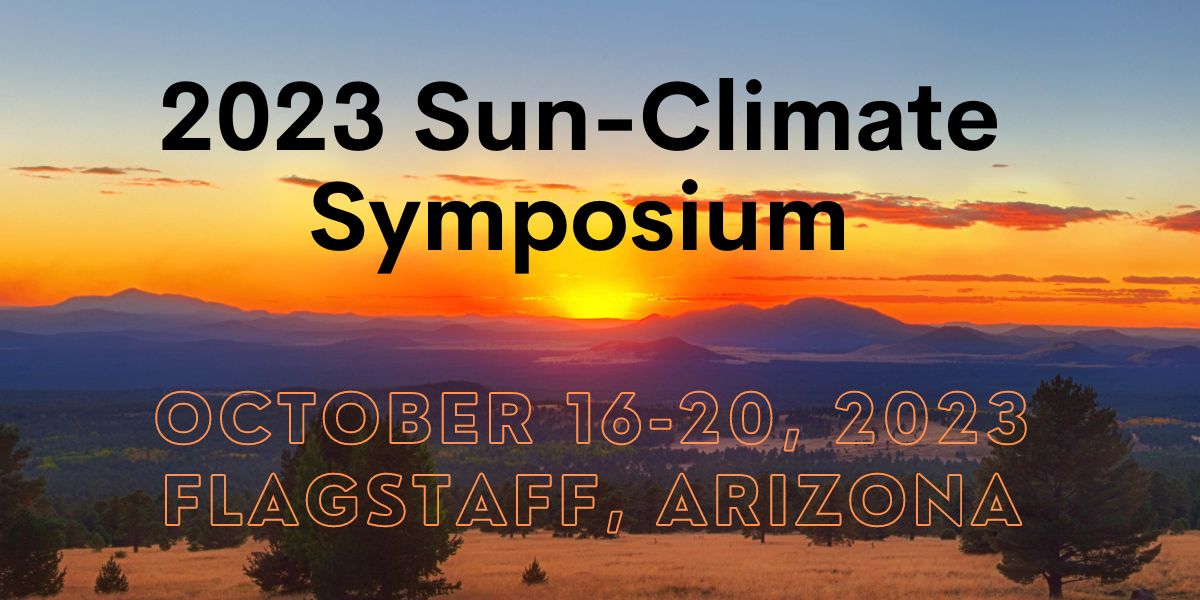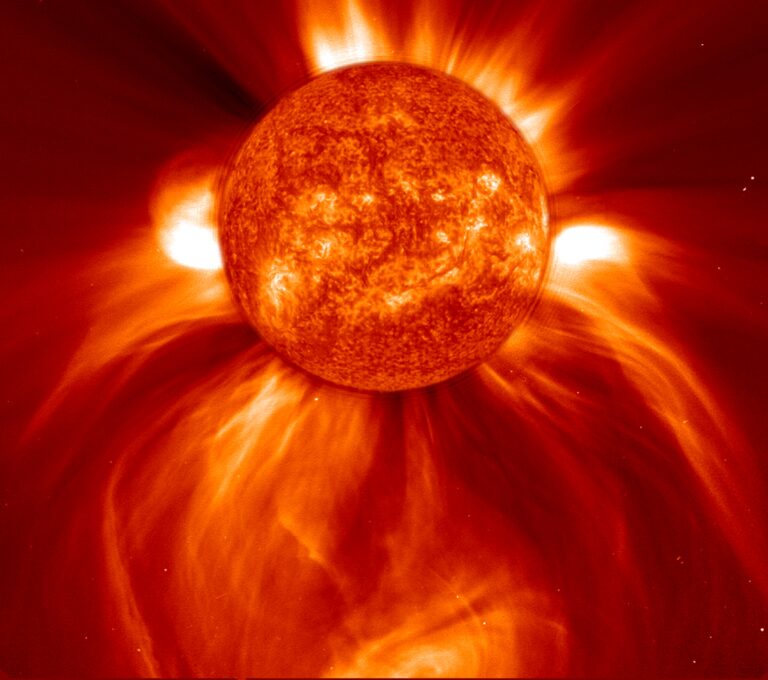
Solar and Stellar Variability and its Impacts on Earth and Exoplanets
We are pleased to announce the 2023 Sun-Climate Symposium, which is sponsored by the Sun-Climate Research Center, a joint venture between NASA GSFC and LASP at the University of Colorado Boulder. This Sun-Climate Symposium is planned as an in-person meeting in Flagstaff, Arizona, USA for 16-20 October 2023 with the science theme of “Solar Stellar Variability and its Impacts on Earth and Exoplanets”. We encourage participation from all aspects of climate studies and solar-stellar variability research in this multidisciplinary, international Sun-Climate Symposium.
We hope you can attend this interactive symposium in person, so please save these dates (16-20 October 2023). We will be sending out more information in the coming months about the sessions, the venue, and abstract submissions. We encourage your participation and hope that you will share this announcement with colleagues. Please feel free to contact any of the Science Organizing Committee (SOC) members for any of your questions, as well as contacting the conference coordinator, Kelly Boden (kelly.boden@lasp.colorado.edu).

Synoptic observations of stellar activity cycles began in 1966 with the inception of the Mount Wilson Observatory (MWO) HK Project and have continued at a number of sites since. For some stars, we therefore have time series of Sun-like stars, solar analogs, and solar twins spanning nearly 60 years. More recent ground- and space-based observations show shorter-term activity variability and expand the observations to tens of thousands of stars. Collectively, these data reveal a rich variety of cycle morphologies with important implications for the nature of stellar dynamos, the frequency and nature of grand minima, the timescales of the formation and evolution of magnetically active regions, rotational-period dependencies, and the evolution of stellar and solar activity with time. This session will afford attendees the opportunity to describe observations of solar and stellar activity, present results from extant and future programs, discuss current critical questions, present desired science cases and targets for future studies, and describe upcoming related missions.
The theories of planet evolution have been continuously advancing over the past two hundred years, and comparative studies of our solar system and exoplanets is a rapidly emerging science since the Kepler discoveries of many Earth-like exoplanets. Stellar variability plays a critical role in the climate and evolution of planetary atmospheres via photochemical processes and direction interaction with stellar winds. Recent missions, such as MAVEN provide direct evidence of atmospheric escape processes in our own solar system, while JWST is expected to revolutionize our understanding of photochemistry at exoplanets. Understanding how stars evolve both in the short-term and long-term is therefore essential to understanding the current environment and history of Earth and other planets. This session will explore the types of variability we see from stars and how these different types of variability can affect both our ability to observe and characterize planets. Observational, modeling, and instrumental talks are welcome and encouraged.
The Earth’s climate system comprises several major types of short-term variability that must be understood in the context of longer-term climate change. These include the El Niño-Southern Oscillation (ENSO), the Pacific Decadal Oscillation (PDO), the Northern and Southern Annular Modes, and various teleconnections between tropical and extratropical regions. At the same time, solar irradiance variability and volcanic eruptions are two dominant natural drivers of climate change. The 27-day solar-rotational variability and the 11-year solar-activity cycle are two well-known solar drivers for atmospheric heating and photochemistry. The volcanic eruptions are highly episodic on a short-term scale, but can have dramatic and rapid impacts on climate, such as from the recent Hunga Tonga-Hunga Ha’apai (HT-HH) eruption on Jan 15, 2022. The radiative forcing from additional water vapor and aerosols from volcanoes may lead to the interactions with other modes of climate variability such as ENSO. This session will present contributions on the radiative and dynamic impacts of internal oscillations, solar variability, and volcanic activity, from the present and pre-industrial times, on short-term climate variability, and also more general contributions toward understanding decadal-scale modes of variability including solar cycle influences.
The prior 11-year solar activity cycle, Solar Cycle 24 (SC-24), was the weakest solar cycle since the early 1900s. The NOAA-NASA Solar Cycle 25 Prediction Panel has forecast that Solar Cycle 25 (SC-25) could be about the same magnitude as SC-24. The solar activity has been weak following the cycle minimum in 2019-2020, but activity has ramped up more substantially in 2022, outpacing the forecast. The recent observations from NASA’s Earth Observing System (EOS) satellites, as well as from many other international satellites and ground-based observatories, are providing trends of the solar variability and climate changes during the rise of SC-25. What are the indicators in climate change that reflect this recent low level of solar activity? Can the low solar activity over SC-24 and during the rise of SC-25 help to refine the understanding of solar forcings on climate changes? This session will focus on those recent observations and related modeling, upcoming related missions, and also on forecasts of solar variability and climate change for the next few years.
Sessions and Descriptions
The agenda for this interactive meeting consists of invited and contributed oral and poster presentations. Five sessions are planned to focus on different science topics related to the main focus topic.
2023 Sun-Climate Symposium Science Organizing Committee (SOC)
- Odele Coddington, Laboratory for Atmospheric and Space Physics
- Jeff Hall, Lowell Observatory
- Dan Lubin, Scripps Institution of Oceanography
- Greg Kopp, Laboratory for Atmospheric and Space Physics
- Jae Lee, NASA Goddard Space Flight Center
- Peter Pilewskie, Laboratory for Atmospheric and Space Physics
- Doug Rabin, NASA Goddard Space Flight Center
- Erik Richard, Laboratory for Atmospheric and Space Physics
- Tom Stone, USGS Astrogeology Science Center
- Ed Thiemann, Laboratory for Atmospheric and Space Physics
- Tom Woods, Laboratory for Atmospheric and Space Physics
- Dong Wu, NASA Goddard Space Flight Center, Laboratory for Atmospheric and Space Physics
Conference Coordinator:
Kelly Boden kelly.boden@lasp.colorado.edu

